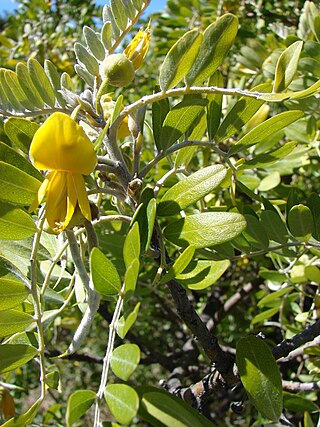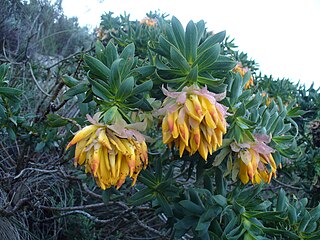
Sophora is a genus of about 45 species of small trees and shrubs in the pea family Fabaceae. The species have a pantropical distribution. The generic name is derived from sophera, an Arabic name for a pea-flowered tree.

Lotononis is a genus of flowering plants in the family Fabaceae and the tribe Crotalarieae. Almost all of the species in the genus occur in southern Africa.

Melolobium is a genus of 15 species of flowering plants belonging to the family Fabaceae. It is native to southern Africa, where it is found in south and east Namibia, southwest Botswana, and most of South Africa.

Tephrosia is a genus of flowering plants in the family Fabaceae. It is widespread in both the Eastern and Western Hemisphere, where it is found in tropical and warm-temperate regions.

Calpurnia aurea is a Southern African tree belonging to the family Fabaceae, occurring along the coastal regions from the south-eastern Cape northwards and inland to the central Transvaal, with an isolated population in eastern Zimbabwe. Mostly found as a small tree up to 4 m, but under forest conditions reaching heights of 15 m. This species produces abundant sprays of bright yellow flowers. Leaves are pinnately compound with a terminal leaflet (imparipinnate). Pods are thin and papery, straw-coloured and about 10 cm in length.

Vachellia is a genus of flowering plants in the legume family, Fabaceae, commonly known as thorn trees or acacias. It belongs to the subfamily Mimosoideae. Its species were considered members of genus Acacia until 2009. Vachellia can be distinguished from other acacias by its capitate inflorescences and spinescent stipules. Before discovery of the New World, Europeans in the Mediterranean region were familiar with several species of Vachellia, which they knew as sources of medicine, and had names for them that they inherited from the Greeks and Romans.

Argyrolobium is a genus of flowering plants in the family Fabaceae. It belongs to the subfamily Faboideae. Members of this genus are found in Africa, western and south Asia, and southern Europe.

Aspalathus is a genus of flowering plants in the family Fabaceae. The yellow flowers and spiny habit of some species have suggested a resemblance to Ulex europaeus, the thorny "English gorse" Accordingly, "Cape Gorse" has been proposed as a common name although the resemblance is largely superficial; for instance, gorse is thorny, whereas Aspalathus species are variously spiny or unarmed. The genus belongs to the subfamily Faboideae. There are over 270 species, mainly endemic to southwestern fynbos regions in South Africa, with over fifty occurring on the Cape Peninsula alone. The species Aspalathus linearis is commercially important, being farmed as the source of Rooibos tea.

Podalyria is a genus of flowering plants in the family Fabaceae. It belongs to the subfamily Faboideae. The genus is endemic to South Africa.

AnacampserosL. is a genus comprising about a hundred species of small perennial succulent plants native to Southern Africa, Ethiopia and Latin America. The botanical name Anacampseros is an ancient one for herbs supposed to restore lost love.

Liparia is a genus of flowering plants in the legume family, Fabaceae. It belongs to the subfamily Faboideae.

Indigastrum is a genus of flowering plants in the tribe Indigofereae of the family Fabaceae.













